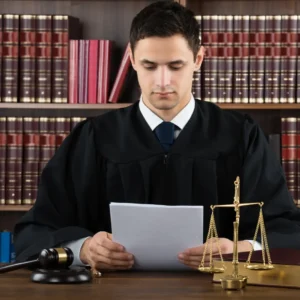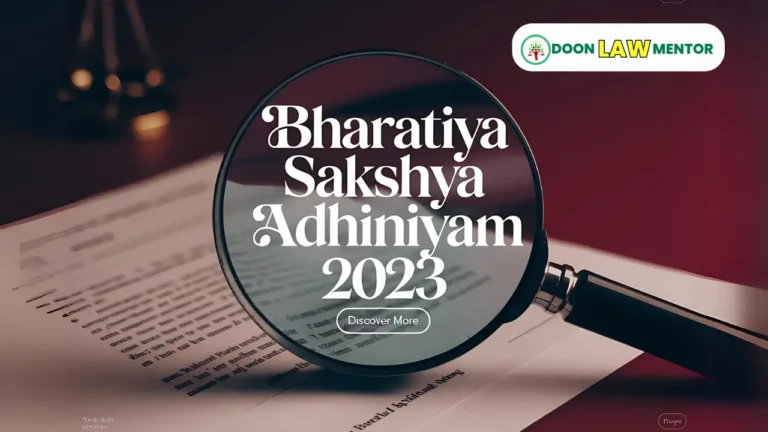In the case of House Owners Welfare Association (Regd.) v. State of Haryana and others (2025 P&H HC), the Punjab and Haryana High Court ruled that prompt medical care is a fundamental right under Article 21 of the Constitution, refusing to quash a layout plan incorporating a clinic in Sector 17, Panchkula, despite claims of increased traffic. Justices Sureshwar Thakur and Vikas Suri emphasized the importance of accessible healthcare for the elderly and disabled, balancing it against the right to trade under Article 19(1)(g). This blog explores the ruling, its legal implications, and its significance for Judiciary, APO, and JLO aspirants preparing for 2025 exams.
Table of Contents
Introduction
On April 5, 2025, the Punjab and Haryana High Court delivered a landmark judgment in House Owners Welfare Association (Regd.) v. State of Haryana and others (2025 P&H HC), affirming that prompt medical care is a fundamental right under Article 21 of the Constitution of India. Justices Sureshwar Thakur and Vikas Suri refused to quash a layout plan incorporating a doctor’s clinic in Sector 17, Panchkula, despite objections from the petitioner over increased traffic.
The court emphasized the importance of accessible healthcare for vulnerable groups like the elderly and disabled, while also upholding the right to trade under Article 19(1)(g) for clinic operators. This ruling underscores the judiciary’s commitment to balancing public welfare with individual rights, making it a significant case for legal analysis. This blog provides a detailed overview of the case, its legal implications, and its relevance for Judiciary, APO, and JLO aspirants preparing for 2025 exams.
Background of the Case: House Owners Welfare Association (Regd.) v. State of Haryana
The House Owners Welfare Association (Regd.), representing residents of Sector 17, Panchkula, filed a petition in the Punjab and Haryana High Court challenging a 2003 demarcation plan and sectoral development plan that carved out a clinic site in their vicinity. The association also sought to quash the advertisement and e-auction of nursing home sites related to the plan.
Petitioner’s Arguments
- Lack of Transparency: The association claimed they were never informed that institutional sites or clinic sites could be established in front of their homes, alleging a violation of procedural fairness.
- Traffic and Accessibility Issues: They argued that the clinic’s location caused significant traffic congestion, making it difficult for residents to access their homes at the end of the street. They highlighted that the existing 5-meter road was inadequate to handle the increased traffic, exacerbating their daily struggles.
- Violation of Rights: The petitioner contended that the layout plan infringed on their right to a peaceful living environment, indirectly affecting their right to life under Article 21.
Respondents’ Defense
- Public Welfare: The State of Haryana and other respondents, including the Haryana Shehri Vikas Pradhikaran (HSVP), defended the layout plan, arguing that the clinic site was part of a broader vision to promote healthcare access in the locality, particularly for the elderly, senior citizens, and disabled individuals.
- Fundamental Right to Trade: The respondents asserted that the clinic operators, having been allotted the sites, were exercising their fundamental right to practice business and occupation under Article 19(1)(g) of the Constitution, which the court should protect.
- Awareness of the Plan: The state pointed out that the layout plan was established in 2003, and the petitioners were aware of it when they purchased their plots in 2004, making their objections untimely.
Court Proceedings
The case was heard by a division bench comprising Justice Sureshwar Thakur and Justice Vikas Suri. The court examined the submissions from both sides, including arguments by the petitioner’s counsel, Mr. Sanjeev Sharma, Mr. Vishal Sodhi, and Mr. B.S. Mittal, and the respondents’ counsel, Mr. Ankur Mittal, Ms. Svaneel Jaswal, Mr. Pardeep Prakash Chahar, Mr. Saurabh Mago, Mr. Gaurav Bansal, and Mr. Karan Jindal. The bench focused on balancing the residents’ concerns with the broader public interest in healthcare access.
The Punjab and Haryana High Court’s Ruling: Key Findings
On April 5, 2025, the Punjab and Haryana High Court dismissed the petition, delivering a judgment that reaffirmed the fundamental right to prompt medical care under Article 21 of the Constitution.
1. Prompt Medical Care as a Fundamental Right
- Article 21 and Right to Health: The court held that prompt medical care is an integral facet of the right to life under Article 21, which guarantees the right to live with dignity. Justices Thakur and Suri noted, “when the consultancy services to be provided at the clinic sites may become availed by the elderly people, senior citizens or disabled people, especially when in absence thereof, it would lead them to travel to long distances for receiving OPD consultancies.”
- Public Welfare Over Individual Concerns: The court emphasized that the clinic’s location within the colony reduces the burden on patients, particularly the elderly and disabled, who would otherwise need to travel long distances to access crowded hospitals or medical centers. This aligns with the state’s duty to ensure healthcare access as part of Article 21.
- Insightful Vision of the Plan: The bench observed that the 2003 demarcation plan was prepared with an “insightful vision” to promote the health of local citizens, stating, “The making of the impugned demarcation plan/sectoral development plan obviously appears to be made with an insightful vision, but for promoting the health of the citizens of the locality concerned.”
2. Addressing Traffic Concerns
- Timeliness of Objections: The court rejected the petitioner’s traffic concerns, noting that they should have raised these issues when they purchased their plots in 2004, as they were aware of the layout plan at that time. The delay in raising objections—nearly two decades—weakened their case.
- Balancing Rights: While acknowledging the residents’ concerns about traffic congestion, the court prioritized the public interest in healthcare access, stating that the clinic’s benefits outweighed the inconvenience caused by increased traffic.
3. Right to Trade Under Article 19(1)(g)
- Clinic Operators’ Rights: The court upheld the fundamental right to practice business and occupation under Article 19(1)(g) for the clinic operators, who were allotted the sites through a legal process. The bench noted, “since the right to practice business and occupation is the fundamental right, to which the respondents concerned are entitled, as they became allotted the clinic sites concerned.”
- No Violation Found: The court found no evidence that the layout plan violated the residents’ rights, as the clinic’s establishment was in line with statutory frameworks like the Haryana Scheduled Roads and Controlled Areas Act, 1963, which did not require public objections for Sector 17, Panchkula, as it was not a “controlled area” under the Act.
4. Alignment with Constitutional Values
- The court concluded that the clinic site “visibly augments the health concerns” of the community, particularly for vulnerable groups, thereby furthering the right to life under Article 21. The ruling reflects a broader judicial trend of prioritizing public welfare over individual grievances when fundamental rights are at stake.
Legal Implications of the Ruling
The Punjab and Haryana High Court’s decision in House Owners Welfare Association (Regd.) v. State of Haryana has far-reaching implications for healthcare access, urban planning, and fundamental rights in India.
1. Strengthening the Right to Health Under Article 21
- Expansion of Article 21: The ruling reaffirms that prompt medical care is a fundamental right under Article 21, building on precedents like Parmanand Katara v. Union of India (1989), where the Supreme Court held that the state has a duty to provide timely medical care to preserve life.
- Urban Planning and Healthcare: By upholding the clinic’s inclusion in the layout plan, the court sets a precedent for prioritizing healthcare infrastructure in urban planning, ensuring that residential areas are equipped with accessible medical facilities.
- Focus on Vulnerable Groups: The emphasis on the elderly, senior citizens, and disabled individuals aligns with the judiciary’s commitment to protecting vulnerable populations, as seen in cases like Francis Coralie Mullin v. Union Territory of Delhi (1981), where the Supreme Court expanded Article 21 to include the right to live with dignity.
2. Balancing Fundamental Rights
- Article 19(1)(g) vs. Article 21: The court balanced the residents’ right to a peaceful living environment (an aspect of Article 21) with the clinic operators’ right to trade under Article 19(1)(g), prioritizing public welfare over individual inconvenience. This aligns with Consumer Education and Research Centre v. Union of India (1995), where the Supreme Court held that the right to health takes precedence in matters of public interest.
- Traffic Concerns Dismissed: The court’s dismissal of traffic concerns as untimely reflects a practical approach, ensuring that long-delayed objections do not derail public welfare initiatives, as seen in Removing Hospital From Residential Area Because It Increased Traffic Violates Fundamental Right To Trade (Web ID 1), where the court similarly prioritized healthcare access over traffic issues.
3. Impact on Urban Development Policies
- Healthcare in Residential Areas: The ruling encourages state authorities to integrate healthcare facilities into residential layouts, reducing the burden on patients and aligning with the National Health Policy, 2017, which emphasizes accessible healthcare.
- Statutory Compliance: The court’s finding that Sector 17, Panchkula, was not a “controlled area” under the Haryana Scheduled Roads and Controlled Areas Act, 1963, clarifies procedural requirements for urban planning, ensuring that public welfare projects are not stalled by unnecessary objections.
4. Judicial Precedent for Future Cases
- Prompt Medical Care as a Right: The affirmation of prompt medical care as a fundamental right sets a precedent for future cases involving healthcare access, potentially influencing policies on clinic placements in residential areas.
- Balancing Rights: The court’s approach to balancing Article 21 and Article 19(1)(g) provides a framework for resolving conflicts between individual rights and public welfare, as seen in Right to Know Medical Status of Human Beings Can Also Be Considered as a Fundamental Right (Web ID 15), where the Punjab and Haryana High Court similarly prioritized health rights under Article 21.
Critical Analysis: Balancing Healthcare Access and Residents’ Concerns
The Punjab and Haryana High Court’s ruling in House Owners Welfare Association (Regd.) v. State of Haryana reflects a progressive stance on healthcare access, but it also raises questions about balancing public welfare with residents’ concerns.
Strengths
- Affirmation of Healthcare Rights: The court’s recognition of prompt medical care as a fundamental right under Article 21 strengthens the judiciary’s role in ensuring healthcare access, particularly for vulnerable groups like the elderly and disabled, aligning with global human rights standards like the Universal Declaration of Human Rights (Article 25).
- Public Welfare Prioritized: By prioritizing the clinic’s benefits over traffic concerns, the court upholds the state’s duty to promote public health, as seen in Consumer Education and Research Centre v. Union of India (1995), where the Supreme Court emphasized the state’s obligation to provide healthcare facilities.
- Support for Right to Trade: The ruling protects the right to trade under Article 19(1)(g) for clinic operators, ensuring that economic rights are not unduly curtailed, as reflected in Removing Hospital From Residential Area (Web ID 1).
- Procedural Clarity: The court’s dismissal of untimely objections (raised 20 years after the plan’s approval) reinforces the importance of timely legal action, preventing delays in public welfare projects.
Challenges and Concerns
- Traffic and Accessibility Issues: The court’s dismissal of traffic concerns overlooks the genuine difficulties faced by residents, such as accessing their homes via a narrow 5-meter road. While the clinic benefits the community, the lack of infrastructure (e.g., wider roads, parking facilities) could exacerbate daily challenges, as reflected in posts on X expressing frustration over “traffic woes in residential areas.”
- Lack of Public Consultation: The petitioner’s claim of not being informed about the clinic site raises questions about transparency in urban planning. While the court found no statutory requirement for objections, greater public consultation could have mitigated resident concerns, as seen in Panchkula RWA, HSVP at Odds Over ‘Conversion’ of School Plot (Web ID 6), where similar transparency issues were raised.
- Potential for Overreach: The broad interpretation of Article 21 to include prompt medical care could lead to overreach in future cases, where public welfare projects might override legitimate individual rights without adequate mitigation measures, such as traffic management plans.
- Implementation Challenges: While the clinic site is a step toward healthcare access, the lack of supporting infrastructure (e.g., multi-level parking, as planned in Removing Hospital From Residential Area (Web ID 1)) may undermine its benefits, as residents’ accessibility issues remain unaddressed.
Critical Perspective
The Punjab and Haryana High Court’s ruling is a progressive step in affirming prompt medical care as a fundamental right, aligning with the judiciary’s evolving interpretation of Article 21 to include health and dignity, as seen in Parmanand Katara (1989) and Francis Coralie Mullin (1981). The court’s focus on vulnerable groups like the elderly and disabled reflects a commitment to social justice, ensuring that healthcare access is not a privilege but a right. However, the dismissal of traffic concerns as untimely overlooks the practical challenges faced by residents, potentially infringing on their right to a peaceful living environment, which is also an aspect of Article 21.
The lack of public consultation in the 2003 plan, as alleged by the petitioner, raises questions about procedural fairness, a concern echoed in Panchkula RWA, HSVP at Odds (Web ID 6). While the BNSS, 2023, effective from July 1, 2024, introduces digital tools like online FIRs to enhance transparency in criminal justice (Web ID 15), urban planning processes could benefit from similar transparency measures, such as mandatory public hearings. A more balanced approach might involve mitigation measures (e.g., wider roads, parking facilities) alongside clinic establishment, ensuring that healthcare access does not come at the expense of residents’ daily lives, thus harmonizing competing rights under Articles 21 and 19(1)(g).
Relevance for Judiciary, APO, and JLO Aspirants
The Punjab and Haryana High Court’s ruling in House Owners Welfare Association (Regd.) v. State of Haryana is a critical case for Judiciary, APO, and JLO aspirants preparing for 2025 exams:
- Prelims: Expect questions on Article 21 (right to life), Article 19(1)(g) (right to trade), the Haryana Scheduled Roads and Controlled Areas Act, 1963, and key cases like Parmanand Katara v. Union of India (1989) and Consumer Education and Research Centre v. Union of India (1995).
- Mains: Write essays on topics like “Prompt Medical Care as a Fundamental Right: Balancing Public Welfare and Individual Rights” or “Judicial Interpretation of Article 21 in Healthcare Access,” discussing Articles 21 and 19(1)(g), judicial oversight, and urban planning, with references to House Owners Welfare Association (2025) and Francis Coralie Mullin (1981).
- Interviews: Discuss the implications of the ruling for healthcare access, urban planning, and fundamental rights, citing 2025 trends and the need for balanced policies to address residents’ concerns while promoting public welfare.
Conclusion
The Punjab and Haryana High Court’s ruling on April 5, 2025, in House Owners Welfare Association (Regd.) v. State of Haryana and others (2025 P&H HC) marks a significant milestone in affirming that prompt medical care is a fundamental right under Article 21 of the Constitution. Justices Sureshwar Thakur and Vikas Suri upheld a 2003 layout plan incorporating a clinic in Sector 17, Panchkula, prioritizing healthcare access for the elderly and disabled over residents’ traffic concerns, while also protecting the right to trade under Article 19(1)(g) for clinic operators.
The decision reflects the judiciary’s commitment to public welfare, aligning with precedents like Parmanand Katara (1989), but raises questions about balancing individual rights with community needs. For Judiciary, APO, and JLO aspirants, this case is essential for 2025 exams, offering insights into fundamental rights, urban planning, and judicial balancing, and preparing them to tackle questions with a nuanced perspective.
Call-to-Action
Master the Punjab and Haryana High Court’s ruling on prompt medical care as a fundamental right for your 2025 exams! Join Doon Law Mentor’s Courses for expert guidance. Follow @doonlawmentor on Instagram for daily legal updates!
FAQs
- What did the Punjab and Haryana High Court rule in House Owners Welfare Association v. State of Haryana (2025)?
The court ruled that prompt medical care is a fundamental right under Article 21, refusing to quash a layout plan incorporating a clinic in Sector 17, Panchkula, despite traffic concerns. - Why did the House Owners Welfare Association file the petition?
The association sought to quash a 2003 layout plan and e-auction of clinic sites, claiming they were not informed and that the clinic caused traffic issues, hindering access to their homes. - What is Article 21’s role in this case?
Article 21 guarantees the right to life, which the court interpreted to include prompt medical care, prioritizing healthcare access for the elderly and disabled. - How did the court address the traffic concerns raised by the petitioner?
The court dismissed the concerns as untimely, noting they should have been raised in 2004 when the plots were purchased, as the layout plan was known then. - What fundamental right did the clinic operators have in this case?
The clinic operators were protected under Article 19(1)(g), which guarantees the right to practice business and occupation, as they were legally allotted the clinic sites. - How does this ruling impact urban planning in India?
It encourages integrating healthcare facilities into residential areas, ensuring accessible medical care, but highlights the need for infrastructure to address traffic issues. - What precedent does this case set for healthcare access?
It sets a precedent that prompt medical care is a fundamental right under Article 21, potentially influencing future urban planning and healthcare policies. - What other cases support the right to health under Article 21?
Cases like Parmanand Katara v. Union of India (1989) and Consumer Education and Research Centre v. Union of India (1995) affirm the state’s duty to provide timely medical care. - What challenges did the court overlook in this ruling?
The court overlooked practical traffic issues, such as the narrow 5-meter road, which could hinder residents’ daily lives, as reflected in public sentiment on X. - Why is this case important for Judiciary aspirants?
It addresses fundamental rights, healthcare access, and judicial balancing, making it a key topic for prelims, mains, and interviews in 2025 exams.










